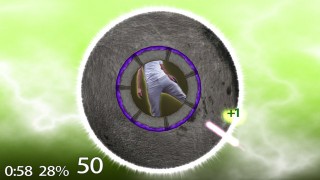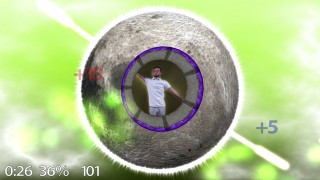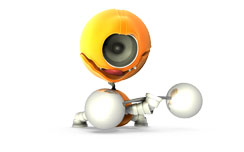
 |
 |
 |
BRIEF DESCRIPTION
The game Space consists in defending a space ship. The patient sees the mirror image of her-/himself located on the ship. The ship is equipped in laser cannons located on the edge of the ship. The patient fires the cannon by touching it. The laser ray from a cannon is fired in the direction to which the cannon points. The patient uses the cannons to neutralize the objects flying towards the patient’s ship.
RECOMMENDATIONS AND POSSIBILITIES
The exercise is mainly recommended for increasing the range of movement of the stretched limbs set in stretched position. The module also develops divided attention and skills of observation. The exercise requires performing certain movements in a set amount of time. While looking at the approaching objects, the patient has to judge which of the objects may reach her/his ship first and eliminate these objects as early as possible. The module can be used in the rehabilitation of cognitive-behavioral functions (the treatment of attention deficit disorder, perception disorders, memory impairment, abnormal thinking, and impaired spatial skills.) Also, the module is recommended as the gauge of the maximum angle in the patient’s range of motion.
PATIENT REQUIREMENTS
The module does not require any special abilities. It also is not required that the patient be fluent in memorizing and identifying the objects which threaten her/his ship. The diverse scoring motivates the patient to focus her/his attention and exercise her/his memory. The patient can perform the exercise either sitting or standing.
TASKS
The patient’s task is to score as many points as possible by shooting down the flying objects. The patient can encounter 3 kinds of objects. For shooting each object of the first kind the patient scores 1 point, and for each object of the second and third kind, the patient scores 5 and 10 points, respectively. What is more, hitting an object of the third kind (worth 10 points) eliminates all the other enemy objects that are in the screen at the given moment. In such case the patient scores the points also for the automatically eliminated objects. Therefore, the most efficient way of scoring points consists in remembering which of the objects are worth more points and always aiming the most valuable object visible in the screen at a given moment. If the patient does not manage to shoot an object down, it hits the patient’s ship. The only consequence of such collision is the unpleasant noise.
DIFFICULTY LEVELS
The module is not divided into actual difficulty levels, but the difficulty is modified by the dynamics of the game and the range of directions from which come the enemy objects. The therapist can change the speed of the flying enemy objects and the number in which they simultaneously appear in the screen. The therapist can also choose which of the patient’s body parts are active during the exercise and adjust the zoom angle.
DATA AND REPORTS
The system saves data concerning the level of the patient’s activity during the exercise, the level of correctness in performing the exercise, and the ranges of movement in the patient’s limbs on the left and right sides of the body.
HINTS AND TIPS
For training the lower limbs (for instance, if the patient is supposed to support the body on one leg and try to maintain balance during the exercise), mark the two lower segments of the wheel in the active area of the game. This will help to avoid the situation where the patient shoots the lower part of the screen when standing still.
More information


This is a modern approach to rehabilitation, which is fun for the patient. This form of a session, from the psychological point of view, brings many positive aspects, which result in stronger effects - desired in terms of improving the functioning of the people undergoing the rehabilitation. Find more Kinect Rehabilitation




